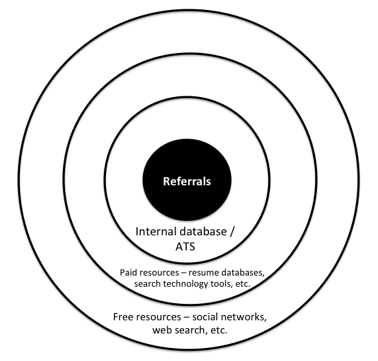Whether or not you want to admit it, we all use some paid resources for our recruiting efforts. This could include any of the following products: job boards, resume databases, information gathering resources (like Jigsaw or ZoomInfo), ATSs, the list goes on and on. Yes – I am talking to you! I know you post jobs on Monster, CareerBuilder, or at least some niche sites from time to time. I know you have purchased an applicant tracking system (that most likely is simply used as a repository for resumes with very little, if any, data organization). If we are spending money on these resources, why, then, do we so adamantly preach and train against using them when conducting candidate searches? If we’re paying for them, then why not justify the cost of using them by actually using them? And if we are not using them, then why continue to pay for them???
Even though I am a researcher and I do not recruit, I learned great “Target Recruiting” in my early days of working in the world of recruiting by studying and talking with my recruiting peers. The idea of the candidate sourcing bull’s-eye is to guide sourcers as well as recruiters in the process of using resources to find candidates. I have revised my own target over the years and am excited to share it with you on The Fordyce Letter.

The bull’s-eye is the first place to start when sourcing: referrals from present and past candidates. And how would you determine whom to connect with for referrals? By utilizing your internal database – your ATS. A paid resource.
The next ring outside of the center for conducting search is the internal database itself. Why? Because these are all folks who have been contacted at some point in time (hopefully) by someone in your company and who have notes attached to their record (again, hopefully) as to their most recent job status. Again, putting a paid resource to good use. Ask yourself this: are you tagging your candidates when you enter them into your ATS? Are you entering candidates into the database in the first place? If you’re not doing this, then you are throwing dollars down the drain by underutilizing a very valuable recruiting and sourcing resource.
Here’s where some people may differ: in my target, the next ring is the paid resources. Why? Because they’ve been paid for. If you’re going to purchase access to a resume database, then you should use it. If you’re of the belief that Monster or CareerBuilder candidates are “garbage” or “already picked through,” then you’re missing the point. About 25% of candidates hired into new roles come from resume databases. Not impressed? According to the most recent Source of Hire survey conducted by CareerXroads, job boards/resume databases were the second highest source of hire…behind referrals. And if that still doesn’t make a dent in your opinion, then think about the fact that you can dig deeply into the resumes in the database to gather competitive intelligence — people list referral contact information on their resumes; and you can also track the companies at which they’ve previously worked, and to which professional organizations they belong. Resume databases can be used as so much more of a resource than just finding active candidates, if you’re opposed to that.
The last places you should be spending time searching for candidates are Internet and free resources — these include social networks, web searches, and so forth. Why? Think of the Pareto Principle — also known as the 80/20 Rule — which postulates that roughly 80% of the effects come from 20% of the causes. Translate this into recruit-speak, and say that 80% of your hires come from 20% of your resources. So, by focusing on the other 80% of your resources, i.e. mostly the free resources, you’ll be paying attention to only about 20% of your potential hiring activity. Free resources are great, but unless you have a very well-defined and well-oiled search process in place for them — or an excellent, efficient, dedicated researcher to conduct free resource searches for you — then you’re spending a lot of time with resources that will yield you less results than the ones for which you pay.
The lesson to be learned here is this: optimize the resources for which you pay. Spend the time organizing your ATS. Learn how to get the most out of your paid resources, which include your resume databases and search technology tools. Train your recruiters on how to use them properly. Do these things and you will justify the cost of purchasing them.
My method, of course, is not the end-all and I welcome your thoughts and opinions on this matter. But perhaps thinking about your reason for purchasing your resources — hopefully to streamline your recruiting process and create a more efficient business — will help you to look at your candidate sourcing from a slightly different perspective.
This article is from the May 2011 print Fordyce Letter. To subscribe and receive a monthly print issue, please go to our Subscription Services page.
